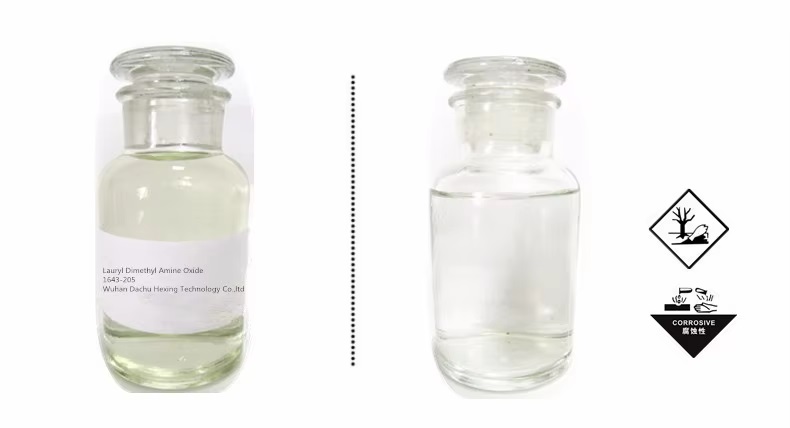Agriculture, Food, Pharmaceutical
Do you have questions?
We unleash your business potential by maximize the business innovation.
Send EmailLauryldimethylamine Oxide , laurilamin oksit, Dodecyl Dimethyl Amine Oxide LADO, Ldao, OA-12, Refan, N,N-dimethyldodecylamine-N-oxide, 1643-20-5
N,N-dimethyldodecylamine-N-oxide
CAS: 1643-20-5
Molecular Formula: C14H31NO
Names and Identifiers
| Name | N,N-dimethyldodecylamine-N-oxide |
| Synonyms | LADO Ldao OA-12 refan Barlox(R) 1260 Lauryldimethylamine Oxide dodecyldimethylamine oxide oxydededimethyllaurylamine Lauryl Dimethylamine Oxide Lauryl Dimethyl Amine Oxide Dodecycldimethylamine oxide N-Alkyl dimethyl amine oxide N-ethyl-N-oxido-dodecan-1-amine N,N-dimethyldodecylamine-N-oxide N,N-dimethyldodecan-1-amine oxide n-Dodeycl-N,N-dimethylamine-N-oxide DDAO, Lauryldimethylamine N-oxide, LDAO |
| CAS | 1643-20-5 |
| EINECS | 216-700-6 |
| InChI | InChI=1/C14H30NO/c1-3-5-6-7-8-9-10-11-12-13-14-15(16)4-2/h3-14H2,1-2H3/q-1 |
Physico-chemical Properties
| Molecular Formula | C14H31NO |
| Molar Mass | 229.4 |
| Density | 0.996g/mLat 20°C |
| Melting Point | 132-133°C(lit.) |
| Boling Point | 371.32°C (rough estimate) |
| Flash Point | 113°C (closed cup)(235 |
| Water Solubility | Insoluble in water. |
| Vapor Presure | 0Pa at 25℃ |
| Appearance | Transparent yellow liquid |
| Specific Gravity | 0.97 |
| BRN | 1769927 |
| pKa | 4.79±0.40(Predicted) |
| Storage Condition | -20°C |
| Stability | Stable. Incompatible with strong oxidizing agents. Combustible. |
| Sensitive | Hygroscopic |
| Refractive Index | n20/D 1.378 |
| MDL | MFCD00002049 |
| Physical and Chemical Properties | This product is colorless or light yellow transparent liquid, the relative density of 0.98 at 20 deg C. Soluble in water and polar organic solvents, slightly soluble in non-polar organic solvents in aqueous solution shows non-ionic or cationic characteristics. When the pH value <7 is cationic, Amine oxide itself is an excellent detergent, can produce stable and rich foam, melting point of 132~133. |
| Use | It is used as a foam promoter, conditioner, thickener and antistatic agent for shampoos, liquid detergents and foam baths, and is also a raw material for the synthesis of amphoteric surfactants. |
Risk and Safety
| Hazard Symbols | C - Corrosive |
| Risk Codes | R34 - Causes burns R52/53 - Harmful to aquatic organisms, may cause long-term adverse effects in the aquatic environment. |
| Safety Description | S26 - In case of contact with eyes, rinse immediately with plenty of water and seek medical advice. S36/37/39 - Wear suitable protective clothing, gloves and eye/face protection. S45 - In case of accident or if you feel unwell, seek medical advice immediately (show the label whenever possible.) S27 - Take off immediately all contaminated clothing. |
| UN IDs | UN 3259 8/PG 2 |
| WGK Germany | 2 |
| RTECS | JR6650000 |
| FLUKA BRAND F CODES | 3-10 |
| TSCA | Yes |
| HS Code | 29299090 |
| Hazard Class | 8 |
| Packing Group | III |
safety
Low irritation to the skin. It should be stored in a cool and ventilated warehouse.
Preparation method
Add 300kg of dimethyldodecylamine, a small amount of water, and a small amount of stabilizer into the reaction kettle. Heat up to 50-55 ℃ with stirring, and start adding hydrogen peroxide dropwise at a dosage of 55kg. After the dripping is completed, continue to heat up to 60-70 ℃ until no heat is released, cool, discharge, and fill the finished product.
Reference Information
| LogP | 1.85 at 20℃ |
| use | this product is mainly used for tableware detergent and industrial liquid bleach. it has the function of increasing foam and stabilizing foam, and can improve the compatibility of thickener and the overall stability of the product. It is used as a foam accelerator, conditioner, thickener and antistatic agent for shampoo, liquid detergent and foam bath, and is also a raw material for synthesizing amphoteric surfactant DDAO is a non-denaturing zwitterionic detergent of about 1 mM(CMC), which is used to dissolve protein and study protein configuration and molecular interaction. N,N-Dimethyldodecylamine N-oxide |
| production method | 300 kg of dimethyltwelve amine, a small amount of water and a small amount of stabilizer are put into a reaction kettle, the temperature is raised to 50~55 ℃ under stirring, and hydrogen peroxide is added dropwise at a dropwise dosage of 55kg. After dropping, continue to raise the temperature to 60~70 ℃ until no heat is released, cool, discharge and fill the finished product. |
